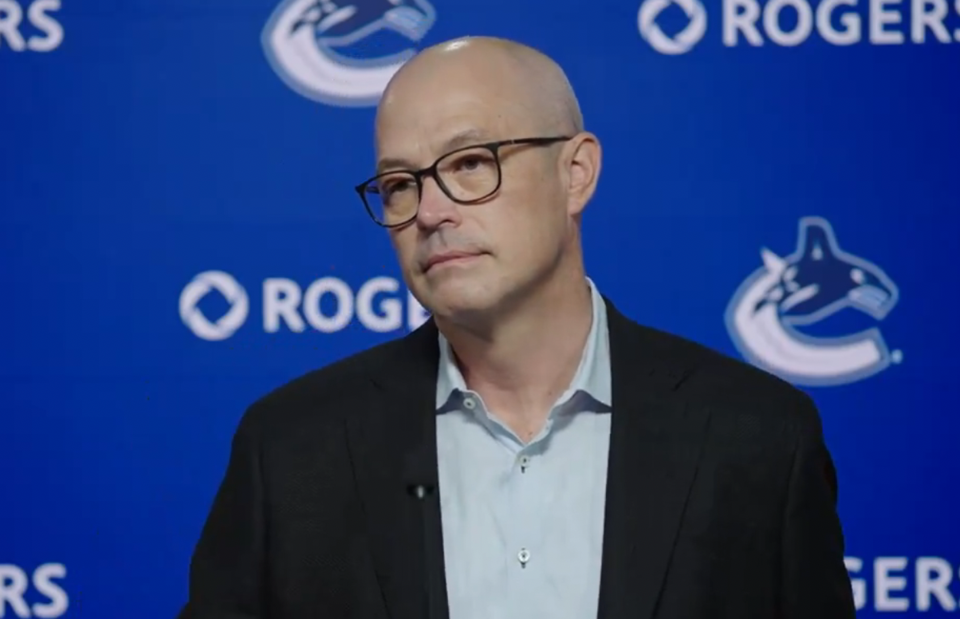The Vancouver Canucks had no interest in waiting until the NHL trade deadline to make a significant move.
In trading for Elias Lindholm over a month ahead of the trade deadline, general manager Patrik Allvin revealed just how much value he and his management team placed in acquiring a forward to augment the team’s top-six. It also follows in the footsteps of his mentor, Jim Rutherford, who didn't like to wait until the deadline to make Cup-winning trades.
Ahead of his Stanley Cup win with the Carolina Hurricanes in 2006, Rutherford similarly made a major trade at the end of January, acquiring Doug Weight. In 2016, ahead of the Pittsburgh Penguins winning the Stanley Cup, Rutherford acquired Carl Hagelin in January, who played a key role on the team's second line — the HBK line — in the postseason. In 2017, Rutherford's key trade came a week ahead of the deadline, acquiring Ron Hainsey, who played on the Penguins' top pairing as they won the Cup.
"I don't think our first-round pick was a priority."
Beyond the timing of the trade, Allvin also invested one of the Canucks’ biggest trade chips — their 2024 first-round pick — to acquire Lindholm. Among the assets the Canucks had available, however, the first-round pick was outranked.
"Based on the conversation I had with the team, I don't think our first-round pick was a priority,” said Allvin via Zoom on Thursday. “There are other players in our pipeline that are way more prioritized than that first-round pick.”
The Canucks managed to avoid parting with those players, hanging onto their top-three prospects: Jonathan Lekkerimäki, Tom Willander, and Elias Pettersson.
Allvin did have to part with one prized prospect, however: 2023 third-round pick Hunter Brzustewicz.
It can be bittersweet for a team’s scouts and development team to see a prospect like Brzustewicz get moved. To see a third-round pick develop the way he has to become one of the top players in the OHL this season is immensely rewarding and reflects well on the Canucks’ staff. On the other hand, to have a prospect develop in such a way that they become good enough to be a key part of a blockbuster trade is its own kind of reward.
“I mean, it's tough to let any player go and this is where it's part of the business,” said Allvin. “I think you're building up your pipeline and your asset pool and those are the sorts of discussions that I weekly, or day-to-day almost, have with my player development staff and our scouting staff to see where each prospect is in their path to make it to the NHL.
“The reason why Hunter was in this deal was that Calgary really liked him — as well as us — and credit to my scout scouting staff, drafting a player of this caliber in the third round.”
"It's coming down to tough match-ups."
So why was Lindholm a priority for the Canucks? Why was a top-six forward the team’s first priority heading into the trade deadline rather than another need, such as a right-shot defenceman?
According to Allvin, it’s because the team needed a stronger two-way game out of their top-six forwards.
“I felt that our bottom-six, the way it's constructed right now and the way they're playing, have found a chemistry and identity of how to play every night and they've been very consistent,” said Allvin. “I feel our top-six needed to improve a little bit with the caliber of a player like Elias [Lindholm] to find more consistency going down the stretch.
“We all know the match-ups going down the stretch in the last 33 games, it's coming down to tough match-ups, and that's where you need your four lines to be strong in the two-way game. That's where we felt that adding a piece like Elias here for the cost that we paid — for now, but potentially for the future as well — was something that we felt strong about.”
It makes a lot of sense when you consider the biggest issue for the roster player that went back to the Flames in the trade: Andrei Kuzmenko. He struggled with the stricter system of head coach Rick Tocchet and had significant defensive miscues.
“We, as a team, got better, we played with more structure, and our system is way more demanding,” said Allvin when asked about Kuzmenko. “And we’re a good team. The other teams are not taking us lightly.”
In other words, Kuzmenko couldn’t meet the demands of the system and wasn’t able to step up as opposing teams took the Canucks as a more serious threat.
"I could see Elias and Elias...working together here."
Lindholm, on the other hand, has a stronger and more structured defensive game that should be a far better fit with Tocchet. With how much the entire team has been scoring, Lindholm’s struggles to score this season are far less of a concern, though his scoring could perk up with a linemate like Elias Pettersson, not to mention a regression of his 6.9% shooting percentage this season.
“I’ll put it this way: I think we have several guys here that can put the puck in the net,” said Allvin.
Lindholm’s versatility compared to Kuzmenko strengthens the Canucks’ top-six considerably. He’s a right-shot centre with experience playing on the wing in the NHL, who plays on both sides of special teams. When he’s not scoring, Lindholm can still contribute to wins in a multitude of ways, which can’t be said of Kuzmenko.
His versatility gives the Canucks new lineup options in the top-six that didn’t exist before.
“[Rick Tocchet] has talked about it that they like the pairs — working in pairs,” said Allvin. “I could see Elias and Elias — Lindholm and Pettersson — working together here, compensating each other, and bringing a little bit of difference of player type here, so I could see the coach giving them a chance to play together.”




